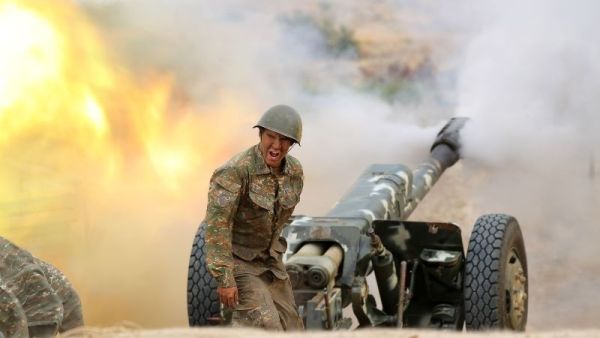The pit that has enveloped Syria continues to provide fertile ground for conflicts around the region.
In a disputed region between Armenia and Azerbaijan, fighters from Syria have been spotted. Reportedly deployed there by Turkey to aid Azerbaijan, their presence signals yet again that Turkey is using its control over northwestern Syria as a recruitment pool for expendable troops.
Previously, Turkey had organized Syrian fighters to battle Kurds. Shortly thereafter, Ankara sent thousands of Syrian mercenaries to fight for the U.N.-backed government in the ongoing Libyan civil war. Now, hundreds Syrians find themselves fighting alongside Azerbaijan’s military in another border flare-up in Nagorno-Karabakh.
Analysts and journalists are focusing on the link between Syrian mercenaries and Turkish president Erdogan’s aggressive foreign policy, but a broader dimension underlying the move remains: countries are increasingly turning to mercenaries, paramilitaries, and unofficial auxiliary forces to do the job of war-making.
Syria is quickly becoming the embodiment of mercenarism’s worst tendencies.
The U.S. relied on a plethora of private military contractors during its invasion and occupation of Iraq starting in 2003.
Iran has used thousands of desperate Afghani refugees as cannon fodder in its intervention of Syria. Russia is deploying shadowy Wagner Group forces around the globe to secure the geopolitical and financial interests of its ruling class.
Turkey’s newfound reliance on vulnerable Syrians to be its military spearhead is merely the latest example of mercenarism—something the international community has yet to seriously reckon with. Unabated, this strategy makes the conclusion of conflicts tougher.
At its worst, it creates a host of incentives for ravaged countries to remain broken so as to provide an endless stream of fighters for hire. Syria is quickly becoming the embodiment of mercenarism’s worst tendencies.
“Our leader told us that we won’t be fighting, just assisting in guarding some areas,” One anonymous Syrian fighter sent to fight in Nagorno-Karabakh told reporters. “Our salaries aren’t enough for living, so we see it a great opportunity to make money.”
Some Syrian fighters have been sent to guard oil and gas facilities in Azerbaijan, and have the opportunity to make over $1,000 a month in salary. This is substantially higher than the expected wage in war-torn rebel areas of northwestern Syria, which continues to suffer from a country-wide economic crisis.

Turkish-organized Syrian fighters in Turkey (AFP/FILE)
“There are no jobs available,” the anonymous fighter’s brother relayed. “I used to work as a tailor in Aleppo but since we were displaced to Azaz [after Aleppo fell to Assad in 2016], I’ve tried many times to practice my craft but my family and I can’t earn enough.”
This latest round of fighting in Nagorno-Karabakh began in July after a series of small-scale border skirmishes between both sides that lasted for around two weeks. Current clashes, which began in the latter part of September, are escalating quickly.
Armenia claims that Azerbaijan is deploying long-range artillery, while it also boasts of downing a Turkish F-16. Turkey has staunchly backed Azerbaijan, while Russia has called for a ceasefire but has traditionally offered support to Armenia.
A potential cascade effect like this in Nagorno-Karabakh could derail any mediating efforts offered by regional power-brokers such as Iran.
The addition of the Syrian fighters by Turkey to aid Azerbaijan could have the effect of emboldening that country’s claim to the border region, and force Armenia to seek its own international backing in the form of troops or logistics.
The first real international test of Turkey’s Syrian mercenary strategy came in Libya, where they were used to blunt an offensive against Tripoli from the Tobruk-based warlord General Khalifa Haftar, who himself relies heavily on the use of mercenaries. In the short-term, the Syrians proved effective in preventing Haftar from making inroads into Tripoli.
In the long-term however, the ability for one side to cheaply deploy foreign fighters enables a war’s indefinite continuation as long as they can continue to be recruited and supplied. Local conflicts can spill into regional power-grabs with the help of soldiers of fortune, who often have little material recourse but to be sent to various warzones.
In the Libyan example, neither side appears serious about negotiating a peace deal, since they both stand to gain from jostling over Libya’s resources and political landscape with the use of mercenaries.
A potential cascade effect like this in Nagorno-Karabakh could derail any mediating efforts offered by regional power-brokers such as Iran.
While Turkey and Azerbaijan deny the existence of the Syrians in the conflict, Erdogan took to Twitter to defend Azerbaijan. “The Turkish people stand with their Azeri brothers with all our means, as always,” adding that Armenia represents “the biggest threat to peace and stability in the region.”
As it stands, little is preventing Turkey from pouring yet more Syrians into the border clashes. For all intents and purposes Erdogan is using Syrians as his bludgeon.
The pit that has enveloped Syria continues to provide fertile ground for conflicts around the region. In a disputed region between Armenia and Azerbaijan, fighters from Syria have been spotted. Reportedly deployed there by Turkey to aid Azerbaijan, their presence signals yet again that Turkey is using its control over northwestern Syria as a recruitment pool for expendable troops. Previously, Turkey had organized Syrian fighters to battle Kurds. Shortly thereafter, Istanbul sent thousands of Syrian mercenaries to fight for the U.N.-backed government in the ongoing Libyan civil war. Now, hundreds Syrians find themselves fighting alongside Azerbaijan’s military in another border flare-up in Nagorno-Karabakh. Analysts and journalists are focusing on the link between Syrian mercenaries and Turkish president Erdogan’s aggressive foreign policy, but a broader dimension underlying the move remains: countries are increasingly turning to mercenaries, paramilitaries, and unofficial auxiliary forces to do the job of war-making. Syria is quickly becoming the embodiment of mercenarism’s worst tendencies. The U.S. relied on a plethora of private military contractors during its invasion and occupation of Iraq starting in 2003. Iran has used thousands of desperate Afghani refugees as cannon fodder in its intervention of Syria. Russia is deploying shadowy Wagner Group forces around the globe to secure the geopolitical and financial interests of its ruling class. Turkey’s newfound reliance on vulnerable Syrians to be its military spearhead is merely the latest example of mercenarism—something the international community has yet to seriously reckon with. Unabated, this strategy makes the conclusion of conflicts tougher. At its worst, it creates a host of incentives for ravaged countries to remain broken so as to provide an endless stream of fighters for hire. Syria is quickly becoming the embodiment of mercenarism’s worst tendencies. “Our leader told us that we won’t be fighting, just assisting in guarding some areas,” One anonymous Syrian fighter sent to fight in Nagorno-Karabakh told reporters. “Our salaries aren’t enough for living, so we see it a great opportunity to make money.” Some Syrian fighters have been sent to guard oil and gas facilities in Azerbaijan, and have the opportunity to make over $1,000 a month in salary. This is substantially higher than the expected wage in war-torn rebel areas of northwestern Syria, which continues to suffer from a country-wide economic crisis. Turkish-organized Syrian fighters in Turkey (AFP/FILE) “There are no jobs available,” the anonymous fighter’s brother relayed. “I used to work as a tailor in Aleppo but since we were displaced to Azaz [after Aleppo fell to Assad in 2016], I’ve tried many times to practice my craft but my family and I can’t earn enough.” This latest round of fighting in Nagorno-Karabakh began in July after a series of small-scale border skirmishes between both sides that lasted for around two weeks. Current clashes, which began in the latter part of September, are escalating quickly. Armenia claims that Azerbaijan is deploying long-range artillery, while it also boasts of downing a Turkish F-16. Turkey has staunchly backed Azerbaijan, while Russia has called for a ceasefire but has traditionally offered support to Armenia. A potential cascade effect like this in Nagorno-Karabakh could derail any mediating efforts offered by regional power-brokers such as Iran. The addition of the Syrian fighters by Turkey to aid Azerbaijan could have the effect of emboldening that country’s claim to the border region, and force Armenia to seek its own international backing in the form of troops or logistics. The first real international test of Turkey’s Syrian mercenary strategy came in Libya, where they were used to blunt an offensive against Tripoli from the Tobruk-based warlord General Khalifa Haftar, who himself relies heavily on the use of mercenaries. In the short-term, the Syrians proved effective in preventing Haftar from making inroads into Tripoli. In the long-term however, the ability for one side to cheaply deploy foreign fighters enables a war’s indefinite continuation as long as they can continue to be recruited and supplied. Local conflicts can spill into regional power-grabs with the help of soldiers of fortune, who often have little material recourse but to be sent to various warzones. In the Libyan example, neither side appears serious about negotiating a peace deal, since they both stand to gain from jostling over Libya’s resources and political landscape with the use of mercenaries. A potential cascade effect like this in Nagorno-Karabakh could derail any mediating efforts offered by regional power-brokers such as Iran. While Turkey and Azerbaijan deny the existence of the Syrians in the conflict, Erdogan took to Twitter to defend Azerbaijan. “The Turkish people stand with their Azeri brothers with all our means, as always,” adding that Armenia represents “the biggest threat to peace and stability in the region.” As it stands, little is preventing Turkey from pouring yet more Syrians into the border clashes. For all intents and purposes Erdogan is using Syrians as his bludgeon.








